First Triathlon Tips: 10 Things to Know Before You Tri
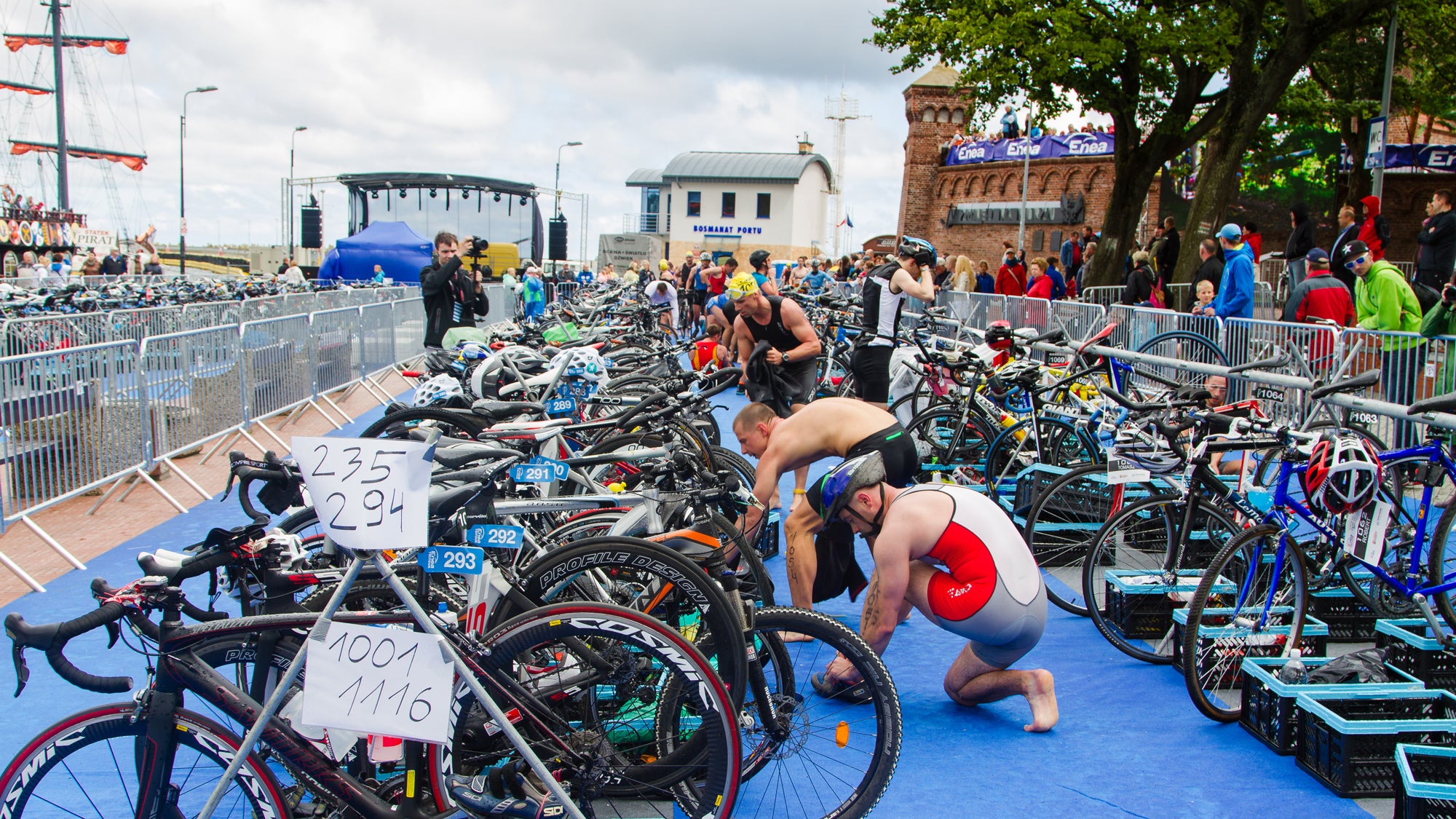
So, you signed up for a triathlon. You clicked the register button feeling all of the things, excitement, nerves, and maybe (probably) a little panic. Now what?
Maybe you look online for some advice on blogs or download a training plan, and you start seeing things like “brick workout,” “CSS,” and “fartlek” wondering if you need to learn an entirely new language on top of putting in the training time. Three sports? How are you supposed to train for three sports?
Here’s the truth: Every triathlete started the same way. Feeling overwhelmed. Wondering if they belonged. Questioning if they could really do this. But step by step, workout by workout, it starts to click. It all seems absolutely insane until you are in the day-to-day of it. You don’t need to be perfect. You just need to keep showing up.
This sport has a way of transforming people. It teaches you what you’re capable of, builds confidence in places you didn’t expect, and introduces you to a community unlike any other. But it’s also a bit confusing when you’re just getting started, and no one hands you a manual.
That’s where this guide comes in. Whether you’re training for your first sprint or just trying to survive the swim, here are 10 things every first-time triathlete should know before race day. From training tips to gear advice to race-day rules, we’ll help you start strong, stay consistent, and maybe even fall in love with this crazy sport.
Don’t be like me. I remember lining up for my first 70.3 with only 10 weeks of training-ish, and zero clue what I was getting into. I panicked in the swim (swimming in a wetsuit for the first time on race day), the bike was a grind, and by the run, I was just trying to hang on, under-fueled and suffering. I finished it, but I didn’t race it; I barely survived it. It taught me a powerful lesson, and it is the reason I became a coach: You don’t have to learn the hard way.
We’ve all been in your shoes at some point. We’ve felt the jitters, the self-doubt, but also that electric energy at the start line. Instead of doubt, arm yourself with a plan, knowing you’ve done everything you can to prepare for this moment.
Here’s what we’ll cover in this guide:
- Essential triathlon gear
- Wetsuits are magic
- Where to train
- How to eat (when you compete)
- The mental game
- Don’t go it alone
- Know the rules of the road
- Have a solid training plan
- Don’t try anything new on race day
- Your first race won’t be your last
1. Essential triathlon gear
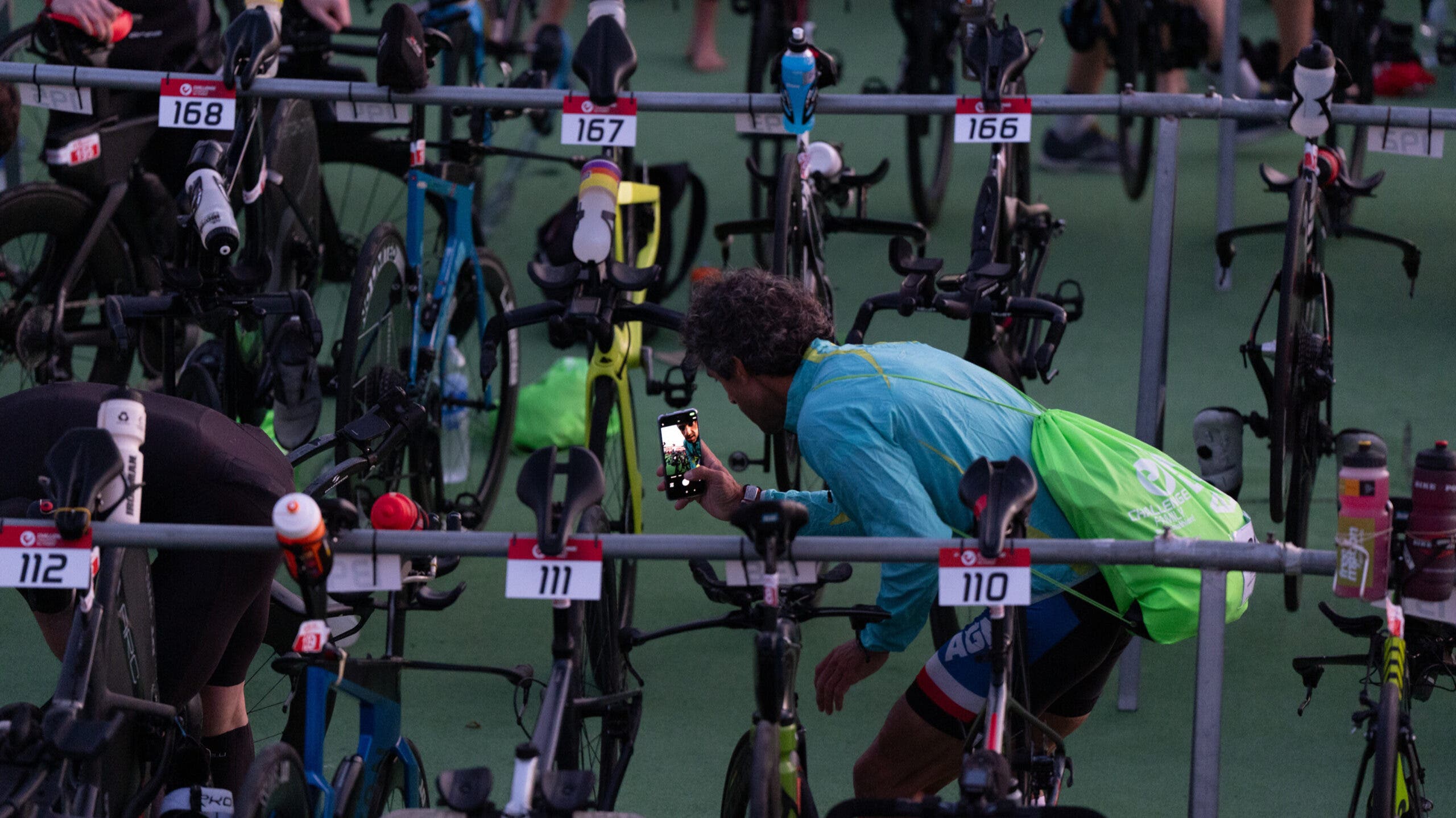
If you’ve done any shopping for triathlon gear, you know it can get expensive fast. But really, you don’t need the best equipment for your first triathlon. You just need equipment that will perform and work for you. For example, you want to know the tri suit you buy won’t rub your skin uncomfortably or hold in heat close to your body. But you also don’t need the most aero, high-performance suit on the market.
But finding a good balance between budget and comfort in triathlon can be challenging, and weeding through what you actually need versus what hobbyists have fun experimenting with can be challenging. Here’s a look at essential beginner tri gear.
- Bike: But it doesn’t have to be a triathlon bike. Heck, it doesn’t even have to be a road bike. Dust off anything in your garage or head to a local garage sale. It simply needs to be a bike you power entirely and on two wheels. Complete a tune-up before using it for training, and get out there.
- Helmet: Skip the aero helmet and get something safe that protects your head and that you’ll willingly wear. It’s required on race day, but really you should think of it as required anytime you pedal your bike.
- Goggles: You need a pair that doesn’t leak and that allows for good visibility in open water. It’s helpful to have two pairs – one clear or light-tinted for pool swims or cloudy open water days, and one smoke-tinted for sunny open water days.
- Race belt: You won’t need this for training, but you do need it on race day to display your race bib.
- Wetsuit: Whether you need a wetsuit comes down to many factors. First off, check to see if your chosen race is generally wetsuit legal. When the water temperature reaches a certain point (78 degrees for USA Triathlon-sanctioned races and 76.1 degrees during Ironman races), the race becomes wetsuit optional, but wearing one means you aren’t eligible for age-group awards. When the water temperature reaches 84 degrees, you are not permitted to enter the water wearing a wetsuit. If you’re a strong swimmer and feel comfortable in the water without the expense of buying a wetsuit, it might be best to avoid adding complexity to your first transition. Athletes who aren’t as strong swimmers or need the hip-raising power of the wetsuit will find it a helpful tool in feeling confident and logging a decent swim time.
- Sunglasses: You don’t need to go all out and buy the most expensive pair of sunnies you can find. But you do need something that will block wind and bugs on the bike and help improve your comfort on the run.
- Running shoes: Get a pair of good beginner running shoes that will support your body throughout training and racing.
- Optional but helpful: You don’t have to wear a tri suit for your first triathlon. You can wear a swimsuit during the swim and pull on bike shorts or athletic shorts for the bike and run – especially for short-course races. But a tri suit will provide the ultimate comfort because it’s designed to carry you through every leg of the sport.
2. Wetsuits are magic
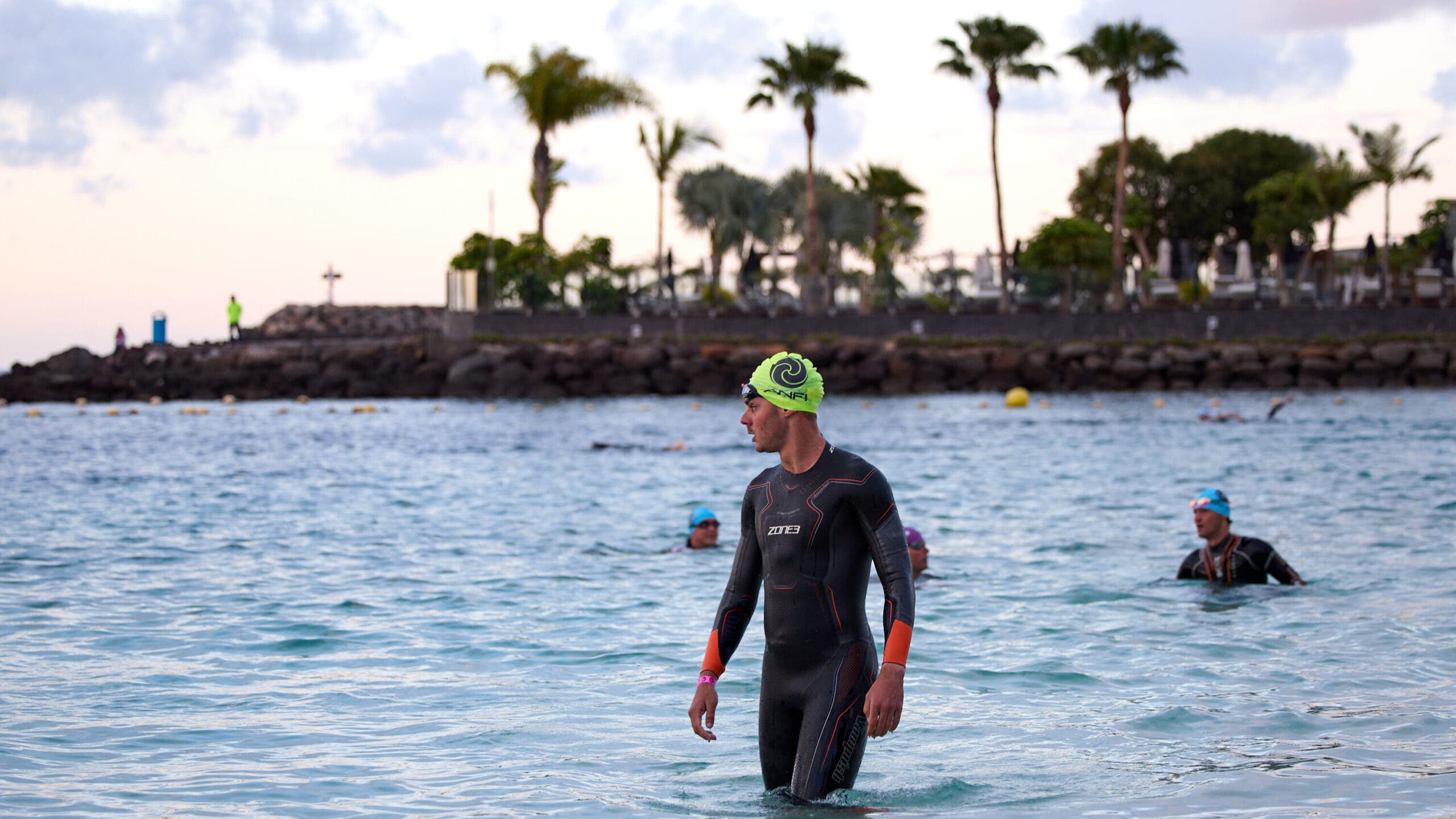
Warm, yes, but also …
When most triathletes think about wearing a wetsuit in the swim leg of a triathlon, they assume that it’s simply for comfort and warmth. But ironically, that’s rarely the best reason to wear a triathlon wetsuit (but yes, it is one reason).
Sure, a wetsuit will keep you warmer, but as you’re putting out so much energy swimming (remember, you’re not just floating there waiting for the next wave to hop on your surfboard), in many conditions, you’ll warm up to a safe and comfortable level, regardless. So then what’s the biggest reason for a wetsuit? It makes you faster, like a lot faster.
For most triathletes, especially those with little to no swim background, their swim form isn’t good for a number of reasons, but one of the most common – and speed-robbing – form culprits is poor body position in the water: You should look like a flat plank in the water, but instead many of us look like a teeter-totter with a huge weight mismatch, legs sinking like lead and head floating like a fish bobber.
We won’t get into why that happens – there are several reasons, many unique to each individual – but the easiest way to fix that total “anchor position” that can slow you down literally by minutes (and make you work harder too) is to wrap yourself in the swim-specific neoprene of a triathlon wetsuit. This’ll literally make you faster with less effort.
You’re not surfing, you’re swimming (hard)
Now, if you’re reading carefully, you’ll understand that I chose the phrase “swim-specific neoprene” and “triathlon wetsuit” very carefully. That’s because while a surf wetsuit is easy to find in the closet or at a garage sale or at a surf shop – and it’ll keep you plenty warm in the water – it’s decidedly NOT for triathlon swimming. If a surf wetsuit is the difference between getting borderline hypothermia and/or finishing your swim because you need it to keep you safe and warm, wear the surf wetsuit; otherwise, steer clear if you can.
Swim/triathlon wetsuits are made with three main functions that surf wetsuits literally don’t care about:
First, a highly flexible torso section allows you to stroke and rotate as freely as possible. While a surf wetsuit is made with shoulder rotation in mind, it’s not made with whole body rotation in mind, and it requires a very dense, durable (inflexible) chest panel to prevent more delicate neoprene from getting thrashed on a waxed surfboard. Conversely, wear a triathlon wetsuit even once surfing, and you’ll likely be Googling “Triathlon wetsuit replacement sale” after your (expensive) surf session.
Second, triathlon/swimming wetsuits are designed to float your lower half in a way that is anathema to surfing. Surf wetsuits actually need a high level of flexibility to get you from prone to “pop” to standing on the board. Triathlon wetsuits typically use a much thicker neoprene that sacrifices flexibility (all you need to do is scissor kick, really) but floats your butt (and legs) way better.
Finally, surf wetsuits assume you’re effectively stationary for much of your time in the water, only really getting your heart rate up for a handful of seconds as you paddle to catch the wave. Triathlon wetsuits know you’ll be at a high heart rate and output basically from the moment you enter the water for a relatively long period of time. Case in point: Wear a surfing dry suit for any triathlon, no matter the temperature, and you’ll likely overheat in less than 10 minutes.
3. Where to train
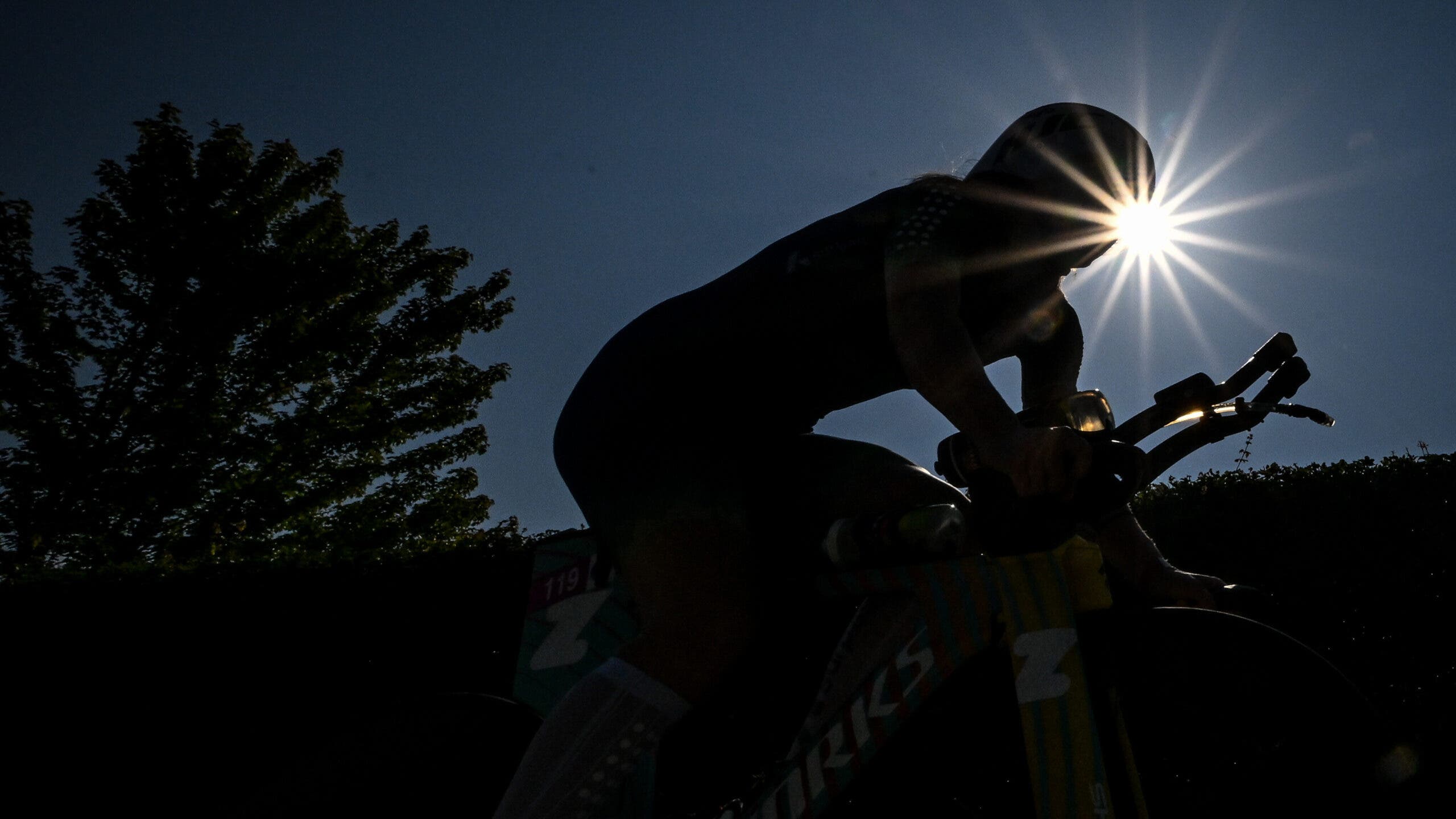
Let’s start with the swim
For most first-timers, this is the biggest mental hurdle. The thought of a long swim in open water is often the most intimidating part of the sport. Start by getting to know your local pool schedule or finding swim groups or clubs that welcome beginners. Take the time to work on technique and build the fitness to cover the distance in a more controlled environment, like a pool, before heading to the open water. Explore the Learning How to Swim for Triathlon Guide.
Get in open water before race day
Eventually, though, you will need to get more race-specific and do some open water swimming before race day. Here’s how to make the switch from pool to open water. When it comes to lakes, oceans, or rivers – safety is key. Find a local tri club or swim group that does open water swims. If not, bring a friend to your first few sessions. They can swim with you, or be on a standup paddleboard or kayak alongside you, or even spot you from shore.
A brightly colored swim buoy is also a great tool to stay safe and visible around watercraft and for your spotter to keep an eye on you. If it is a wetsuit legal triathlon you are training for, be sure to test out swimming in your wetsuit. The first few times, it can feel restrictive, but the buoyancy it provides will have you moving through the water faster come race day. Also, practice taking it off for smooth and fast T1s.
Hit the road (or trail)
Many training rides and runs can start from your front door, depending on where you live. Use apps like Strava, Komoot, and RideWithGPS to find safe, well-used routes. Better yet, ask a local; there’s usually a group ride or running meetup happening somewhere nearby. It can be intimidating to join a group, but for the most part, people join these group workouts looking for community and support just like you.
Tech that leads the way
These days, if someone sends you a route or you find one online or from an app, you can upload it to your watch or bike computer for turn-by-turn directions. That means you can explore confidently without getting lost.
Tap into the community
This is the best way to get started. Local Facebook groups, club websites, and store bulletin boards are goldmines for finding places to train, people to join, and events to keep you accountable. Don’t be afraid to ask – every triathlete started somewhere, and it’s a pretty incredible community.
4. How to eat (when you compete)
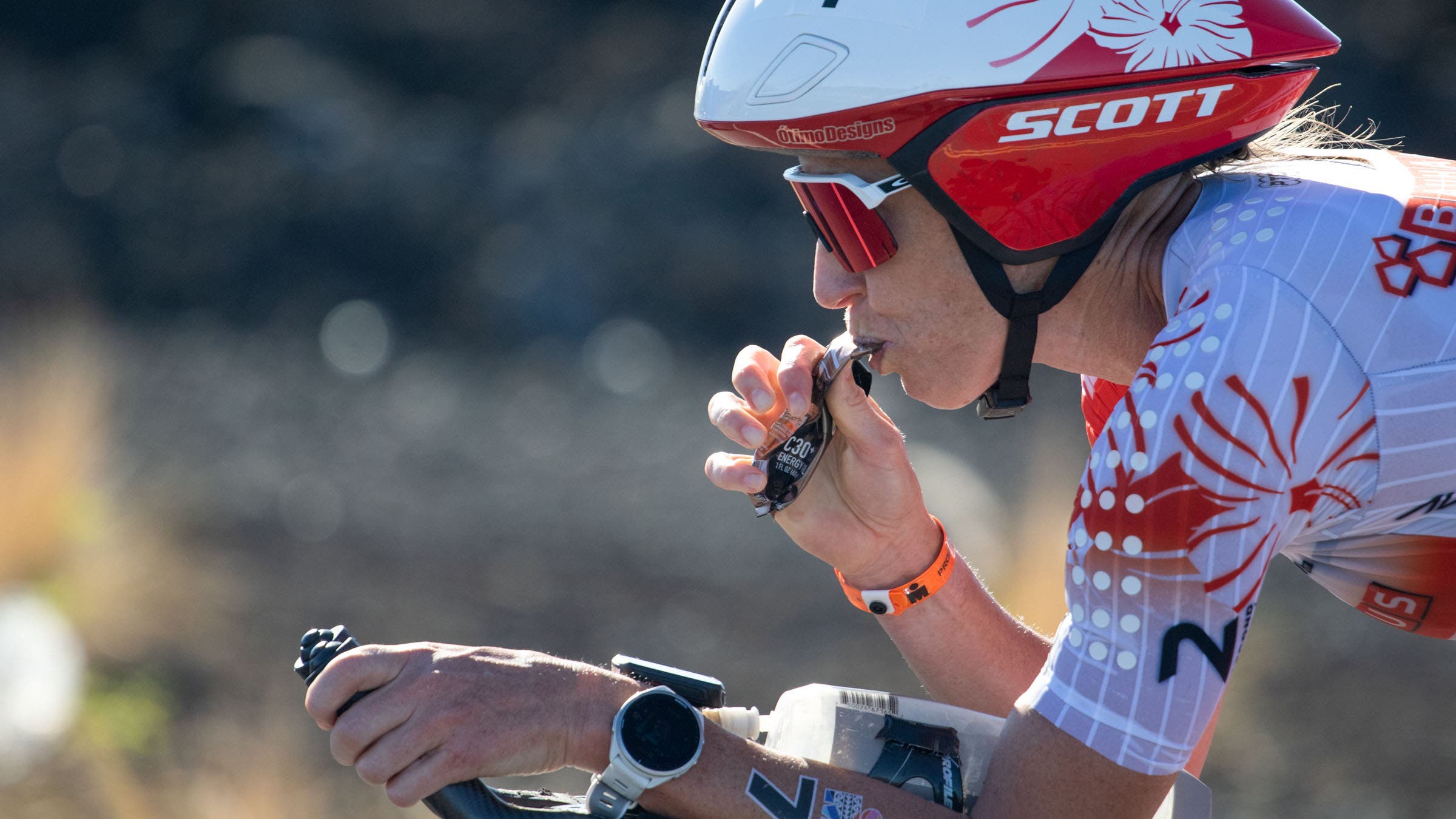
Fuel = performance
Think of your body like an engine; without fuel, it sputters. Race day isn’t the time to go low-carb. The latest research shows that most athletes can tolerate (and benefit from) 90-120 grams of carbohydrates per hour in long-course racing. Top pros like Cam Wurf have taken it even further, clocking over 200g/hour during his record-setting Ironman bike split. While that might be overkill for your first race, it’s a signal: fueling more = going faster. Read How to Fuel for Your First Triathlon for complete details.
Here is a good starting point to practice in training and see what works for you:
On the bike
Short course (Sprint/Olympic):
- Carbs/hour: 30–60g
- Fluids/hour: 500–750ml
- Sodium/hour: 300–600mg
Long course (70.3/Ironman):
- Carbs/hour: 75-120g
- Fluids/hour: 600–1000ml
- Sodium/hour: 500–1000mg
Pro Tip: The bike is your best opportunity to fuel. It’s easier to digest here than on the run. Front-load your energy early to set up a stronger run.
On the Run
Short Course (Sprint/Olympic):
- Carbs/hour: 30–45g
- Fluids/hour: 400–600ml
- Sodium/hour: 300–600mg
Long Course (70.3/Ironman):
- Carbs/hour: 50-90g
- Fluids/hour: 400–800ml
- Sodium/hour: 400–800mg
Pro Tip: Gels and liquid calories work well here, especially when taken with water. Start fueling early on the run to avoid the dreaded bonk.
Practice your plan
Race day is not the time to “wing it.” Use training days to simulate your triathlon nutrition and fueling. Try different gels, chews, drinks, and timing strategies to see what your stomach can handle. Some athletes go all liquids, others like real food. What matters is that it’s tested and works before the big day.
The best way to practice is to do a long bike ride, then a 15-20 minute run off the bike. See how your stomach feels. If it is bloated and you are burping up nutrition, it’s a sign to reduce the amount of calories. If you are feeling tired, sluggish, and mentally don’t feel fired up, it is a sign you are low on carbs and could have used more on the bike.
5. The mental game
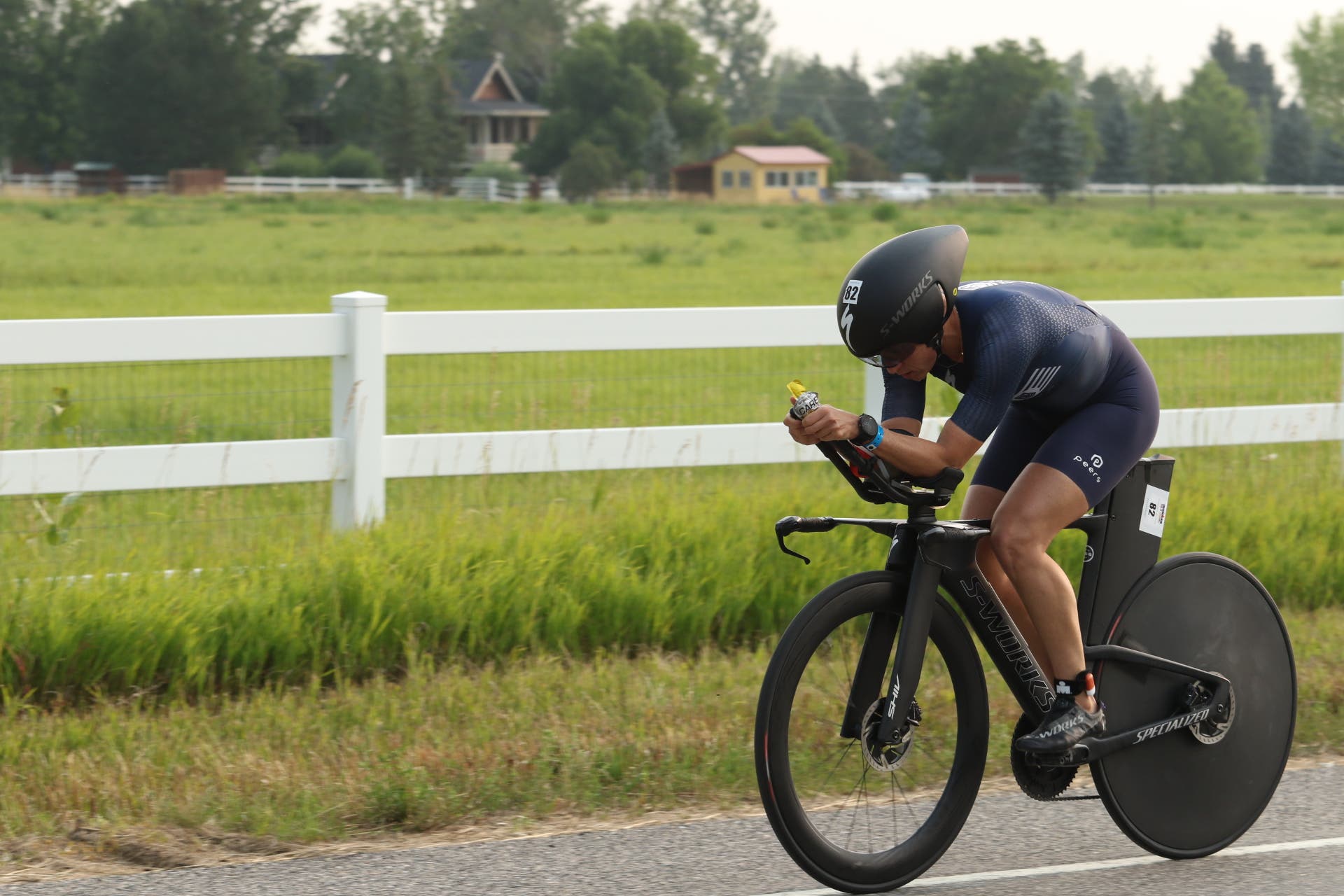
The physical training matters, no doubt. But your mindset? That’s the difference between surviving your first race and actually enjoying it.
Control what you can, let go of the rest
You’re going to see athletes who look stronger, have fancier gear, and seem way more dialed in. Don’t let comparison steal your energy. Your race is yours. The swim, bike, and run don’t care what bike you’re on or how many watts your neighbor is pushing. What matters is how you show up mentally.
Set the right goals
A specific finish time or placing might seem like a good motivator, but it often backfires, especially for first-timers. There are too many things outside of your control, like other competitors, wind, heat, and currents, that affect your results. Instead, aim for intrinsic goals: things like staying calm in the swim, fueling consistently on the bike, or finishing strong on the run. These are the goals that keep you in the moment and help you actually enjoy the experience.
Embrace the nerves
Feeling anxious? That’s normal. It means you care. Most athletes, even the pros, feel that buzz at the start line. Accept it. Breathe through it. And remind yourself: You trained for this. You belong here.
Mental strength is built in training
Use your long rides, open water sessions, and brick workouts to practice getting uncomfortable, accepting that discomfort, and pushing through it. What you do in those tough moments in training becomes your mindset on race day.
Visualize the day
Run through the race in your head. Picture how you’ll move through transitions, how you’ll handle the swim start, how you’ll respond when your legs start to burn. When you’ve already “been there” in your mind, it won’t rattle you when it happens for real.
Bottom line: Race day is going to throw curveballs. Stay steady, stay present, and remind yourself why you signed up in the first place, to push yourself, to grow, and to prove that you’re capable of more than you thought.
6. Don’t go it alone
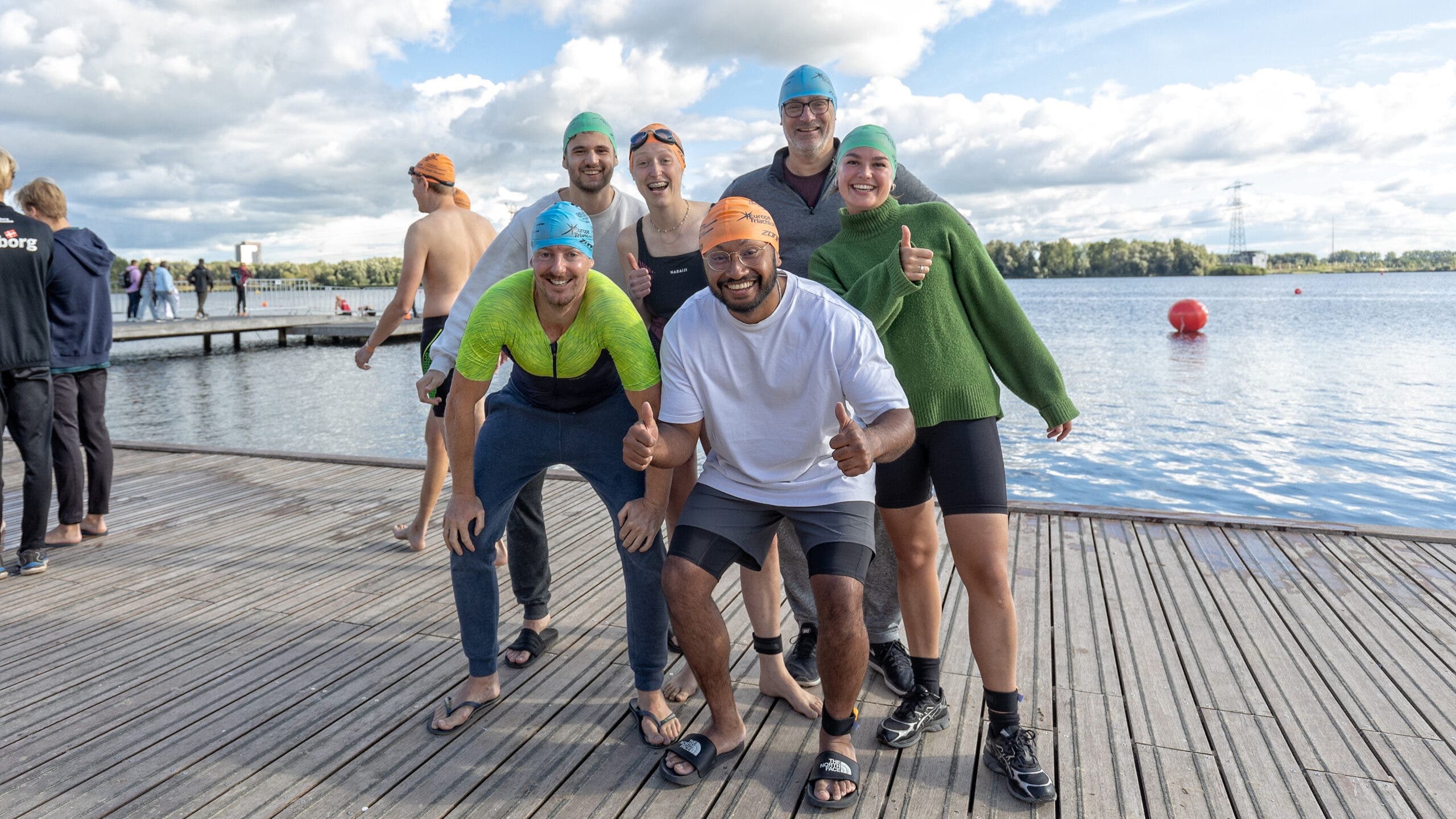
Triathlon can be a solo sport on race day, but you don’t have to do the journey alone.
Train with others when you can
Joining a local tri club, masters swim group, or even hopping in on a weekend ride can make a huge difference. Not only do group workouts hold you accountable, but they’re also more fun, and you’ll pick up tips from more experienced athletes along the way.
Find your crew online
Can’t find a local group? There are thousands of triathletes online sharing their training, asking questions, and building community. Facebook groups, Reddit threads, online triathlon clubs, and even your local Strava leaderboards are great places to connect. And if you’re unsure about something, just ask. This sport has one of the most helpful and encouraging communities out there.
Share your goals
Tell someone you’re doing a triathlon. Post it. Text a friend. The more you put it out there, the more real it becomes, and you’ll find people who support you or even want to join you. There’s a kind of magic that happens when you realize you’re not the only one chasing a big goal.
Remember: Accountability = consistency
Whether it’s a coach writing and tracking your training, checking in with a training partner, an online group or team, or even just a supportive friend, accountability helps keep you honest. Motivation comes and goes, but the community carries you through.
7. Know the rules of the road
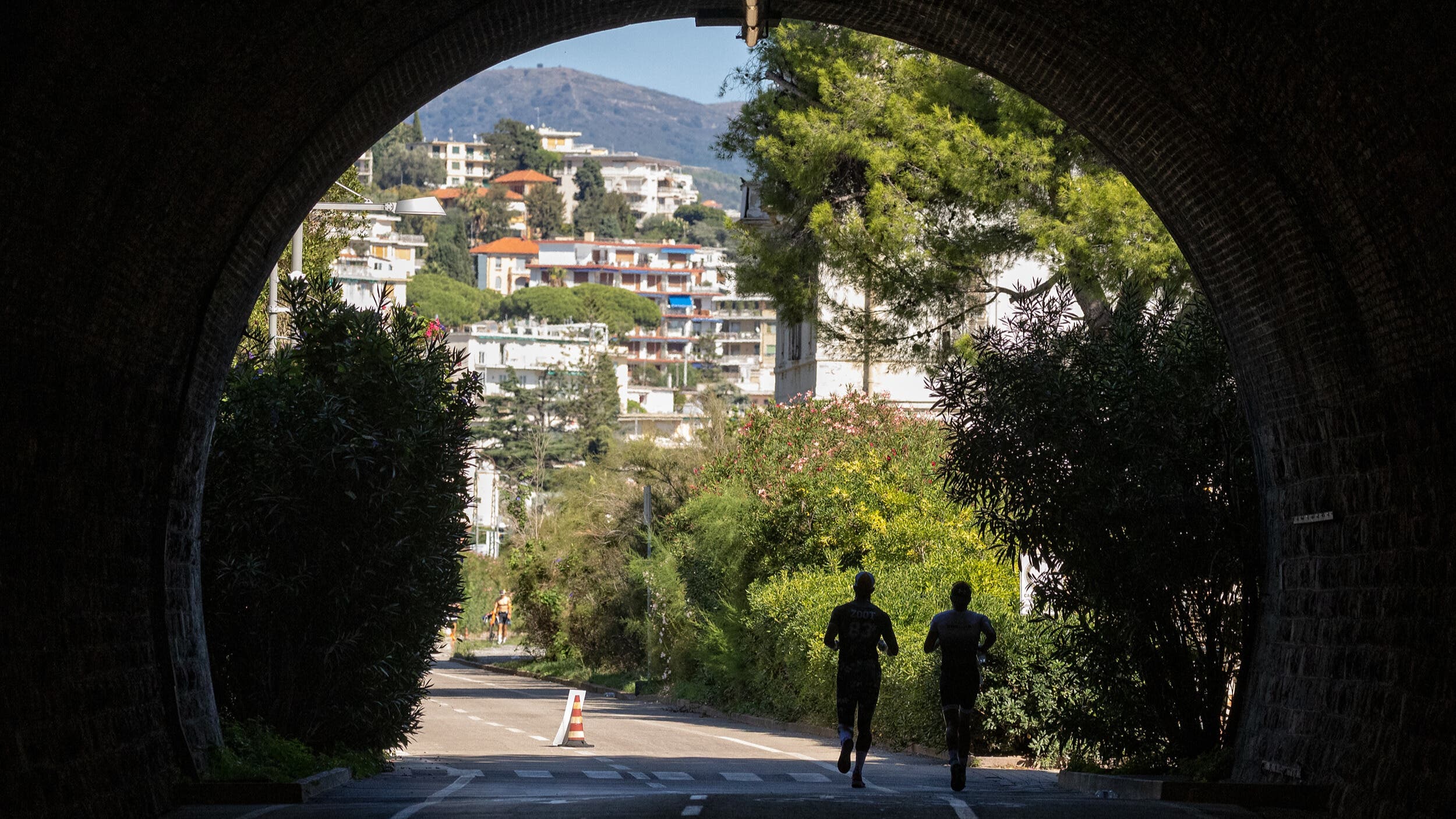
There are a few key rules you’ll need to follow on race day to keep things fair, safe, and stress-free. Every race has its nuances, so be sure to read the athlete guide beforehand, but here are some of the most common rules that catch people off guard. You’ve trained and prepared for this, so make sure your first race doesn’t get slowed down by a penalty or result in a disqualification.
Draft zones are longer than you think
Most non-drafting races follow a 12-meter draft zone – that’s about six bike lengths from the front wheel of the rider ahead to your front wheel. But not all events are the same. Some long-course races now use 20-meter zones. Know your race’s rules and check the athlete guide beforehand. If you enter the draft zone, you have 20 seconds to pass – no lingering, and once you drop back, you must fully exit the zone before trying again.
Blocking and overtaking
If you’re being passed, it’s your responsibility to move right and let the athlete go. Don’t ride side-by-side, and don’t cruise in the middle of the lane. Keep it safe and fair – stay right unless you’re making a pass.
Watch your hydration setup
This is one of the most updated areas in Ironman rules. Front-mounted bottles (between the arms – BTA) are still legal, but now limited to a 4-liter maximum capacity. You can’t ride around with a jug up front – it’s a visibility and safety issue. Test your setup in training. What works on a trainer doesn’t always hold up on race-day pavement.
No headphones allowed
During triathlon competition, there is no music, no earbuds, no exceptions allowed from the start of the race to the finish line. Race day is about awareness, focus, and safety.
Mount and dismount lines
You can’t hop on your bike until you cross the mount line coming out of T1, and you must be off your bike before the dismount line in T2. These areas are often crowded – practice your mount and dismount ahead of time so it’s smooth and not chaotic.
Littering = penalty
If you toss anything outside of an aid station, a gel wrapper, bottle, salt tab packet, it’s a penalty. Race clean and respect the course. Use pockets, storage boxes, and toss items only in the designated zones. If you have trash, hold onto it until the next aid station.
The bottom line
Every race is slightly different. Read the athlete guide. Be there for the pre-race briefing, or watch it online if it’s virtual. Ask questions before race day. You’ve trained for this moment – don’t let a technicality or small mistake derail your race.
8. Have a solid training plan
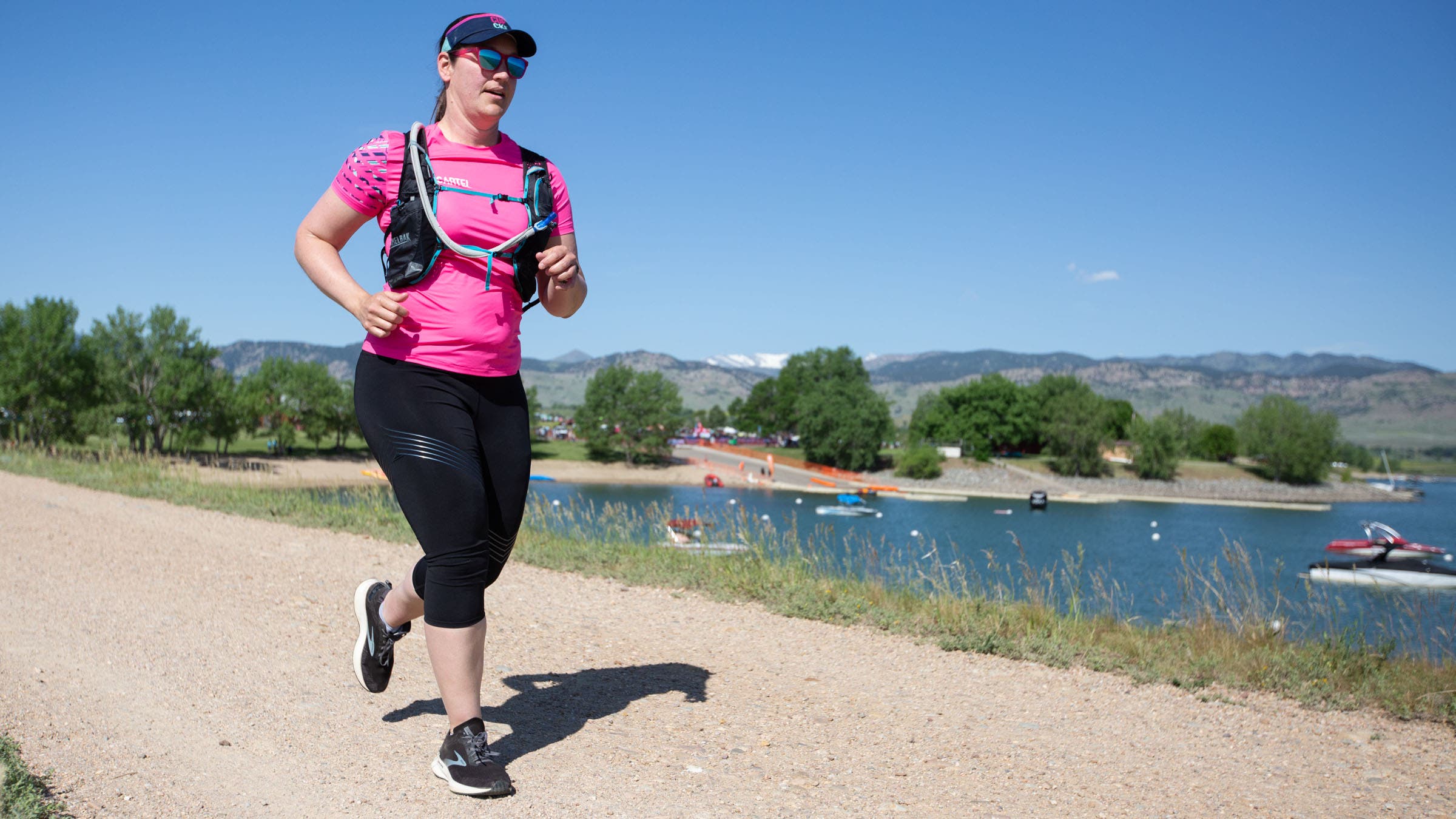
Training for one sport is hard enough. Now you’ve signed up for three. It can feel overwhelming fast. How do you fit it all in? Am I doing too much? Too little? The right things? Those questions swirl in every triathlete’s head at some point.
You don’t need to train like a pro, but you do need a plan. A real one. Not just guessing which workout to do each day or following what your fit friend is doing. Whether your goal is to finish with a smile or chase a time, a solid training plan gives structure, confidence, and progression.
A coach can be a game-changer
If you’re brand new to the sport, working with a coach can help you avoid common first-timer mistakes. You’ll get a customized plan based on your fitness, schedule, and goals, plus someone in your corner when questions pop up. Coaches help balance life and training so you show up on race day prepared.
Plans for every budget
If coaching isn’t in the cards, use a free online training plan. Here’s a curated list of Triathlete’s top training plans for every race distance.
- The Complete Beginner’s Guide on How to Train For Your First Triathlon
- How To Fuel For Your First Triathlon
- A Beginner’s Guide for Learning How to Swim for Triathlon
- 8-Week Sprint Triathlon Training Plan For Beginners
- 12-Week Super Simple Sprint Triathlon Training Plan
- Rock Your First Olympic Triathlon with This 16-Week Training Plan
- A 20-Week Training Plan for Your First 70.3 Triathlon
- Super Simple Ironman 70.3 Triathlon Training Plan
- Super Simple 20-Week Ironman Triathlon Training Plan
Apps that adapt
A newer option that’s growing fast is AI smart training apps that adapt to your performance. Platforms like TriDot, Humango, and MySwimPro use AI and data feedback to adjust your training plan in real time. This can be a great middle ground between a static PDF and one-on-one coaching.
Find what works for your lifestyle
The best plan is the one you can follow consistently. Whether that’s a coach, an app, or a printed schedule taped to your fridge, structure builds fitness and confidence. The work you put in now becomes your race day strength. Show up with a plan, and you’ll show up ready.
9. Don’t try anything new on race day
The golden rule of racing
This one is non-negotiable. No new gear, no new nutrition, no new strategies. Race day is not the time to experiment; it’s the time to execute what you’ve practiced.
Fuel like you’ve trained
If you’ve never tried that on-course gel, don’t grab it on a whim because it’s free. Your gut is trained just like your muscles, and sudden changes can lead to stomach issues, cramps, or worse – a DNF.
Stick to what works
New shoes? Save them for after the race. New tri suit? Test it in training first. Even goggles should be ones you’ve swum in before. Comfort and confidence come from familiarity.
Pacing takes practice
Don’t suddenly decide to go “just a little faster” than you’ve ever done in training. Race day adrenaline is real, but if you blow up early, there’s no saving it in triathlon. Know your effort levels, trust your training, and stick to the plan.
Your race should feel like a dress rehearsal you’ve done dozens of times
From your breakfast to your warm-up to your transitions and nutrition, everything should feel automatic. The fewer surprises you have, the more energy you’ll have to race.
10. Your first race won’t be your last
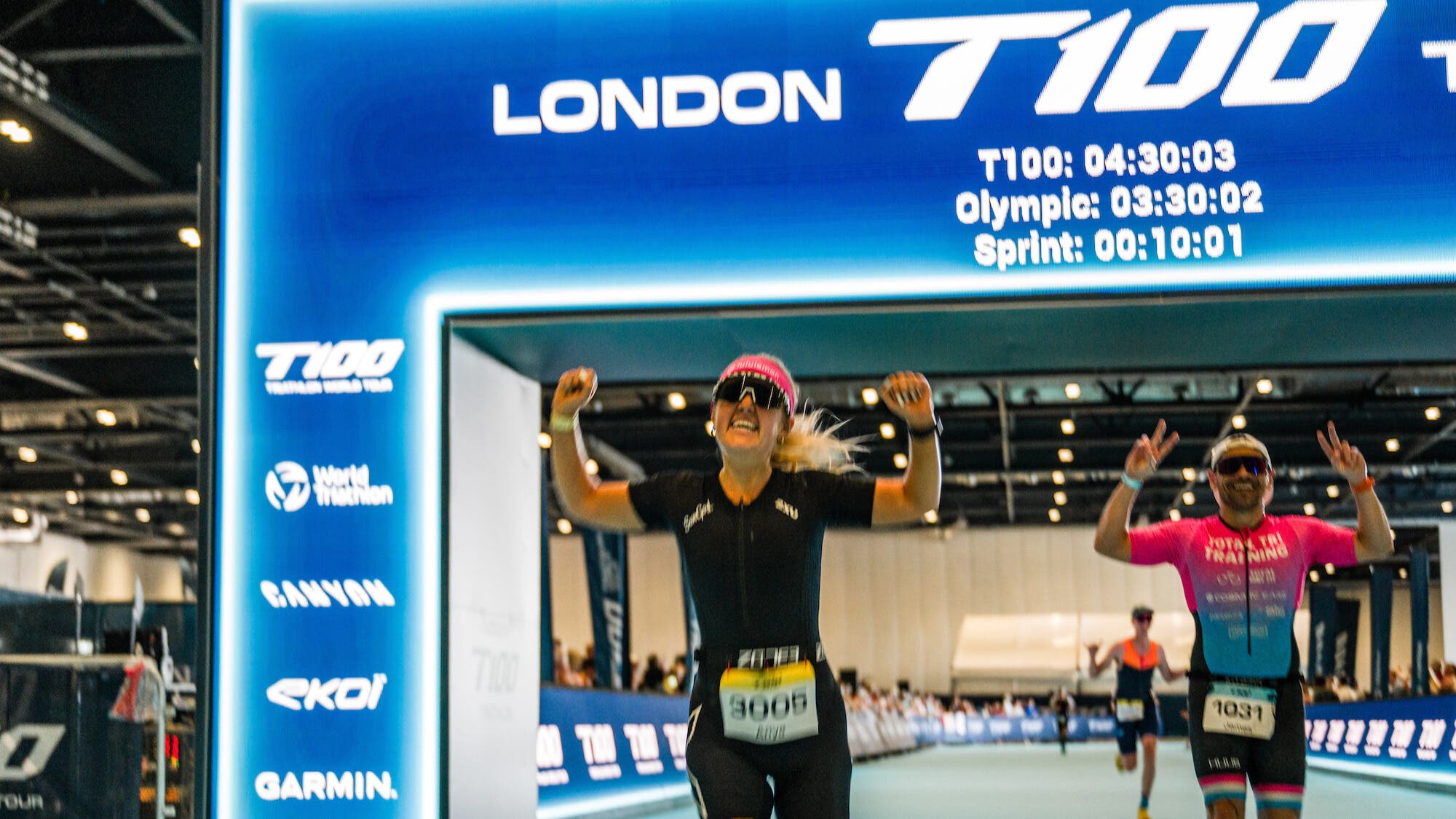
You have no idea what this will unlock
There will be mornings you wake up before the sun and wonder what you’re doing. Training sessions that leave your legs heavy and your lungs burning. Moments where it would be so easy to skip it. But you don’t. You show up. And slowly, this thing starts to change you.
You begin to see what you’re capable of. You start chasing a version of yourself you didn’t know existed – one with grit, who keeps showing up and refuses to settle.
Race day will test every piece of you
At some point out there, you’ll hit a low. You’ll wonder if you really belong here. Whether it was too ambitious. The doubts will get loud. But then something shifts – you take one more stroke, one more pedal turn, one more step – and suddenly you realize you’re doing it. You are that athlete.
The finish line is electric
No one can fully describe what it feels like. You’ve poured weeks, maybe months, into this goal. You’ve struggled, sacrificed, and pushed through. Then – boom – it hits. That final stretch. The noise. The emotion. The relief. The pride. It’s not just a finish line – it’s a transformation.
And you’ll want more
The second your foot hits that finish line, your body aching and your heart full, you’ll know: You’re not done. This sport pulls you in because it shows you who you really are when things get hard – and what you’re capable of when you don’t quit. You’ll already be thinking: “What’s next?”
And that’s the magic. You didn’t just finish your first triathlon – you unlocked something deep. And you’ll be chasing that finish line feeling again and again.